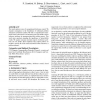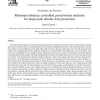31 search results - page 2 / 7 » Structured Encryption and Controlled Disclosure |
NSPW
2006
ACM
13 years 11 months ago
2006
ACM
This work explores issues of computational disclosure control. We examine assumptions in the foundations of traditional problem statements and abstract models. We offer a comprehe...
WPES
2004
ACM
13 years 10 months ago
2004
ACM
In an open environment such as the Internet, the decision to collaborate with a stranger (e.g., by granting access to a resource) is often based on the characteristics (rather tha...
SECURWARE
2008
IEEE
13 years 11 months ago
2008
IEEE
—A security pattern describes a particular recurring security problem that arises in specific contexts, and presents a well-proven generic solution for it [1]. This paper descri...
EOR
2006
13 years 4 months ago
2006
National Statistical Agencies routinely release large amounts of tabular information. Prior to dissemination, tabular data needs to be processed to avoid the disclosure of individ...
PSD
2004
Springer
13 years 10 months ago
2004
Springer
Minimum-distance controlled perturbation is a recent family of methods for the protection of statistical tabular data. These methods are both efficient and versatile, since can dea...


